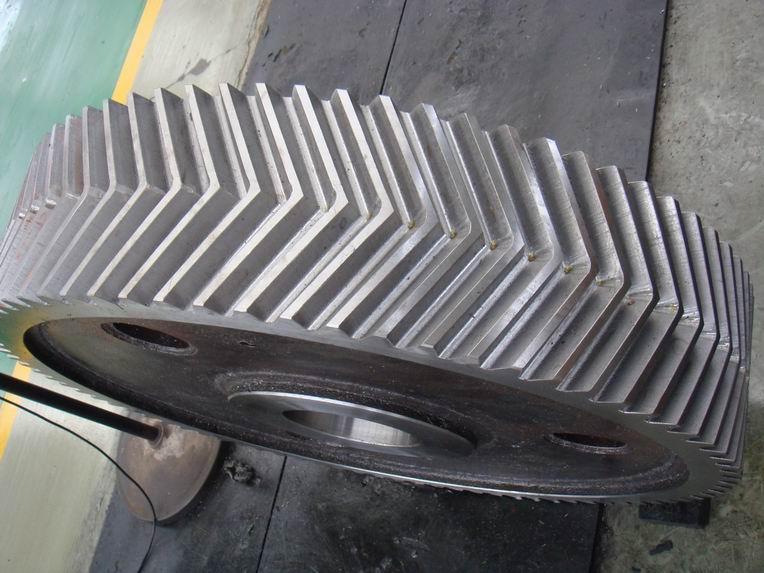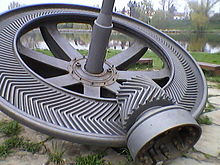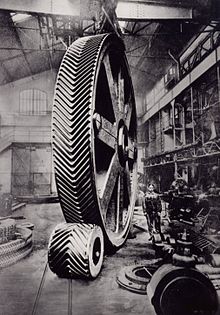Product Description
Product Description
Herringbone gears are a specific type of gear that feature a unique double helix shape resembling the bones of a fish, hence the name “herringbone.” They are characterized by their distinctive V-shaped teeth that are arranged in a herringbone pattern.
Features
Double Helix Shape: The most distinctive characteristic of herringbone gears is their double helix shape, which allows for smoother and more efficient operation compared to traditional spur gears.
Self-Aligning: Due to the opposing helix angles on either side of the gear, herringbone gears are self-aligning. This helps to reduce axial thrust and prevents gear misalignment.
High Load Capacity: Herringbone gears are capable of handling high loads and transmitting significant amounts of power due to their robust design.
Reduced Vibration and Noise: The double helix design helps to cancel out axial forces and minimize vibration and noise during operation, making them ideal for applications where noise reduction is important.
Functions
Power Transmission: Like other types of gears, herringbone gears are primarily used to transmit power between parallel shafts while maintaining a constant speed ratio.
Direction Change: Herringbone gears can change the direction of rotation between 2 shafts while transmitting power efficiently.
Speed Reduction or Increase: By using herringbone gears with different numbers of teeth on the mating gears, speed reduction or increase can be achieved.
/* January 22, 2571 19:08:37 */!function(){function s(e,r){var a,o={};try{e&&e.split(“,”).forEach(function(e,t){e&&(a=e.match(/(.*?):(.*)$/))&&1
| Application: | Machinery |
|---|---|
| Gear Position: | External Gear |
| Manufacturing Method: | Cast Gear |
| Toothed Portion Shape: | Double Helical Gear |
| Material: | Alloy Steel |
| Transport Package: | Wooden Case |
| Customization: |
Available
| Customized Request |
|---|

What is the purpose of using herringbone gears in machinery?
Using herringbone gears in machinery serves various purposes and offers several advantages. Here’s a detailed explanation of the purposes and benefits of using herringbone gears:
- Smooth and Quiet Operation: Herringbone gears are known for their ability to provide smooth and quiet operation. The double helical tooth design cancels out axial and radial forces, minimizing gear vibrations and reducing noise levels during engagement. This makes herringbone gears suitable for applications where noise reduction and smooth operation are essential, such as precision machinery, automotive transmissions, and gearboxes in industrial equipment.
- High Load Capacity: Herringbone gears have a high load-carrying capacity due to their double helical tooth profile. The opposing helix angles of the gear teeth distribute the load evenly, allowing for efficient power transmission even under heavy loads. This makes herringbone gears suitable for applications that involve high torque requirements and heavy-duty machinery, such as mining equipment, construction machinery, and marine propulsion systems.
- Bidirectional Power Transmission: Herringbone gears can transmit power in both directions without the need for additional thrust bearings or special mechanisms. The double helical tooth profile cancels out axial thrust forces, eliminating the net axial thrust on the gear shaft. This bidirectional power transmission capability makes herringbone gears suitable for applications where reversible power transfer is required, such as marine propulsion systems, locomotives, and machine tools.
- High-Speed Applications: Herringbone gears are well-suited for high-speed applications due to their enhanced tooth strength and efficient torque transfer. The double helical tooth design provides increased tooth contact area and improved load distribution, allowing for reliable power transmission at high rotational speeds. This makes herringbone gears suitable for applications such as turbo machinery, power generation equipment, and high-speed gearboxes.
- Reduced Wear and Improved Durability: The double helical tooth profile of herringbone gears helps to minimize wear and improve gear durability. The opposing helix angles distribute the load evenly across the gear teeth, reducing localized stress concentrations and minimizing the risk of tooth failure. This ensures long service life and reliable operation, making herringbone gears suitable for applications where durability and longevity are critical, such as heavy machinery, industrial equipment, and wind turbine systems.
- Efficient Power Transmission: Herringbone gears offer efficient power transmission due to their large contact area and overlapping tooth engagement. The double helical tooth profile provides a larger contact ratio compared to spur gears, allowing for a greater number of teeth in contact at any given time. This efficient torque transfer minimizes power losses and improves overall gear system efficiency, making herringbone gears suitable for applications where energy efficiency is a priority, such as automotive transmissions, gearboxes, and power transmission systems.
The purpose of using herringbone gears in machinery is to achieve smooth and quiet operation, handle high loads, enable bidirectional power transmission, accommodate high-speed applications, ensure durability and longevity, and achieve efficient power transmission. These advantages make herringbone gears a preferred choice in various industries and applications where reliable and high-performance gearing solutions are required.

How do you maintain and service a herringbone gear system?
Maintaining and servicing a herringbone gear system is crucial for ensuring its optimal performance, longevity, and reliability. Regular maintenance and service activities help identify and address potential issues, minimize wear, and extend the lifespan of the gear system. Here’s a detailed explanation of how to maintain and service a herringbone gear system:
- Inspection: Conduct regular visual inspections of the gear system to identify any signs of wear, damage, or misalignment. Inspect the gear teeth, shafts, bearings, and other components for any visible abnormalities, such as pitting, scoring, cracks, or excessive wear. Check for oil leaks, loose fasteners, or any other potential issues that may affect the gear system’s performance.
- Lubrication: Ensure that the lubrication of the herringbone gear system is adequate and meets the manufacturer’s recommendations. Monitor the lubricant level and condition regularly. Check for proper lubricant distribution and coverage on the gear teeth and contact surfaces. Replenish or replace the lubricant as necessary to maintain the required film thickness and lubricating properties.
- Alignment and Clearance: Check and maintain proper shaft alignment to prevent misalignment-related issues. Use alignment tools such as dial indicators or laser alignment systems to verify the parallelism and concentricity of the gear system shafts. Ensure that the gear engagement is correct and that there is appropriate gear backlash. Make any necessary adjustments to optimize gear alignment and clearance as per the manufacturer’s guidelines.
- Fasteners and Connections: Regularly inspect and tighten all fasteners, such as bolts, set screws, or clamps, to ensure that they are securely fastened. Loose fasteners can lead to misalignment, vibration, and potential gear system failure. Follow the recommended torque specifications provided by the manufacturer when tightening the fasteners to avoid over-tightening or under-tightening.
- Monitoring and Analysis: Implement a monitoring and analysis program to track the performance of the herringbone gear system over time. This can include vibration analysis, temperature monitoring, and oil analysis. These techniques can help identify any abnormal conditions, such as excessive vibration, increased temperatures, or the presence of contaminants or wear particles in the lubricant. Regular analysis and monitoring can aid in detecting potential issues early and taking appropriate corrective actions.
- Repair and Replacement: If any signs of wear, damage, or abnormal conditions are detected during inspections or monitoring, take prompt action to address the issues. Depending on the severity of the problem, this may involve repairing or replacing worn or damaged components, such as gear teeth, bearings, or seals. Follow the manufacturer’s guidelines and consult with qualified technicians or professionals for any necessary repair or replacement procedures.
- Documentation and Record-keeping: Maintain accurate documentation and records of all maintenance and service activities performed on the herringbone gear system. This includes inspection reports, lubrication records, repair or replacement history, and any other relevant information. These records can serve as a reference for future maintenance, help track the gear system’s performance, and aid in troubleshooting or warranty claims if needed.
It is important to note that the specific maintenance and service requirements may vary depending on the gear system design, application, and operating conditions. Always refer to the manufacturer’s guidelines, technical documentation, and any applicable industry standards for the recommended maintenance practices and service intervals specific to your herringbone gear system.

What is a herringbone gear and how does it work?
A herringbone gear, also known as a double helical gear, is a specialized type of gear with a unique tooth design. Here’s a detailed explanation of what a herringbone gear is and how it works:
A herringbone gear consists of two helical gear sections that are mirror images of each other and are joined together to form a V-shaped or herringbone-shaped tooth profile. Unlike conventional helical gears, which have a single helix angle and a continuous spiral tooth profile, herringbone gears have two opposing helix angles, resulting in a “V” shape when viewed from the end.
The primary advantage of the herringbone gear design is its ability to eliminate axial thrust or end thrust forces that are generated in helical gears. In a conventional helical gear, the helix angle of the teeth causes an axial force along the gear’s axis during rotation. This axial force can create significant thrust loads that need to be counteracted using thrust bearings or other mechanisms.
By using the double helix design of herringbone gears, the opposing helix angles cancel out the axial forces generated by each helical section. This cancellation of axial forces eliminates the need for thrust bearings and allows herringbone gears to transmit torque smoothly without axial movement or thrust loads.
When a herringbone gear is in operation, the angled teeth of the two helical sections engage with each other, similar to how helical gears mesh. The contact between the teeth occurs gradually, starting from one end of the gear and progressing towards the other end. The overlapping or interlocking tooth profiles ensure a continuous and smooth transfer of power.
The herringbone gear design offers several advantages:
- Axial Load Balancing: The opposing helix angles in herringbone gears balance out the axial forces, eliminating the need for thrust bearings and reducing wear on the gear teeth.
- Increased Load Capacity: The V-shaped tooth profile of herringbone gears provides increased tooth contact area compared to a single helix gear. This leads to improved load distribution and higher load-carrying capacity.
- Reduced Vibration and Noise: The double helix design of herringbone gears helps cancel out vibrations and reduce noise during operation. The opposing helix angles minimize tooth deflection and ensure smoother engagement between the gear teeth.
- Bidirectional Power Transmission: Herringbone gears can transmit power in both directions due to their symmetrical tooth profiles. This makes them suitable for applications where reversing or bidirectional power transmission is required.
- High Efficiency: The continuous and gradual engagement of the herringbone gear teeth results in improved efficiency by reducing sliding friction and minimizing backlash.
Herringbone gears are commonly used in various industrial applications, including power transmission systems, heavy machinery, oil and gas equipment, marine propulsion systems, and high-speed gearboxes. Their unique design and benefits make them well-suited for applications that require high torque transmission, smooth operation, and minimal axial thrust.


editor by Dream 2024-04-19